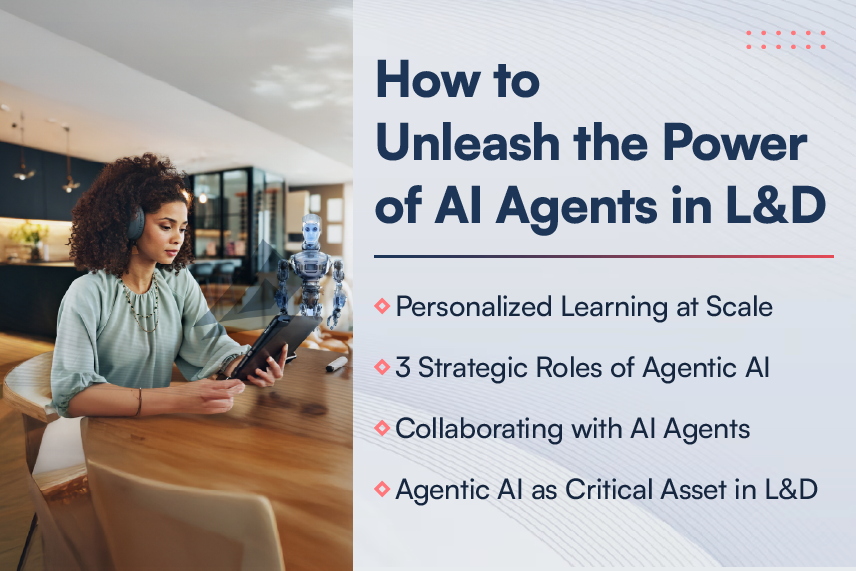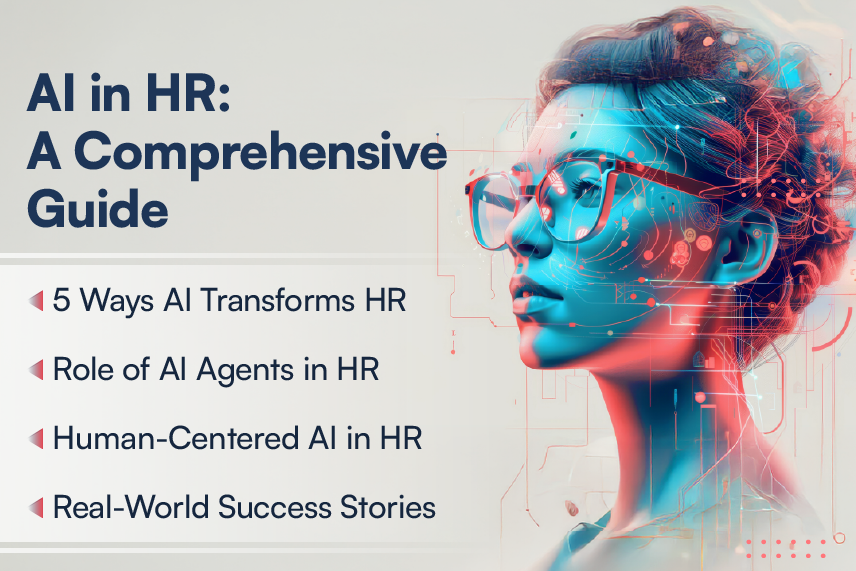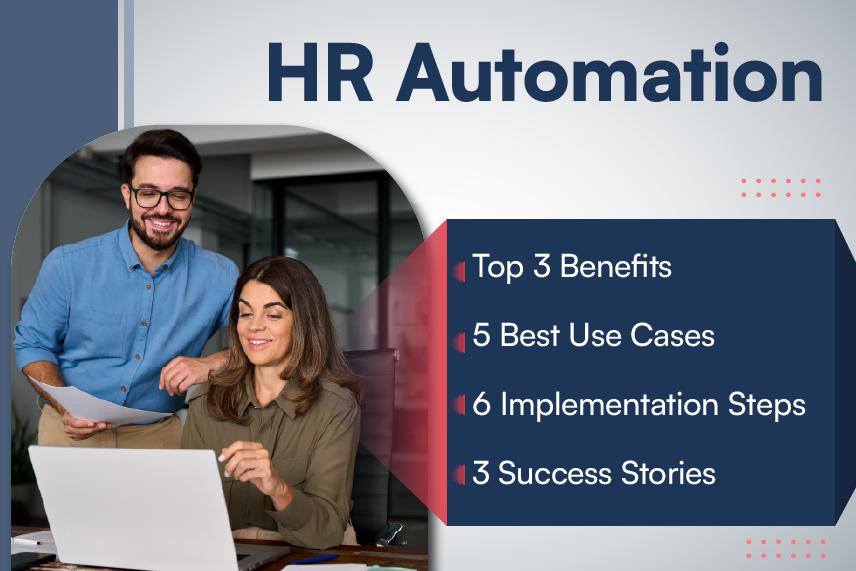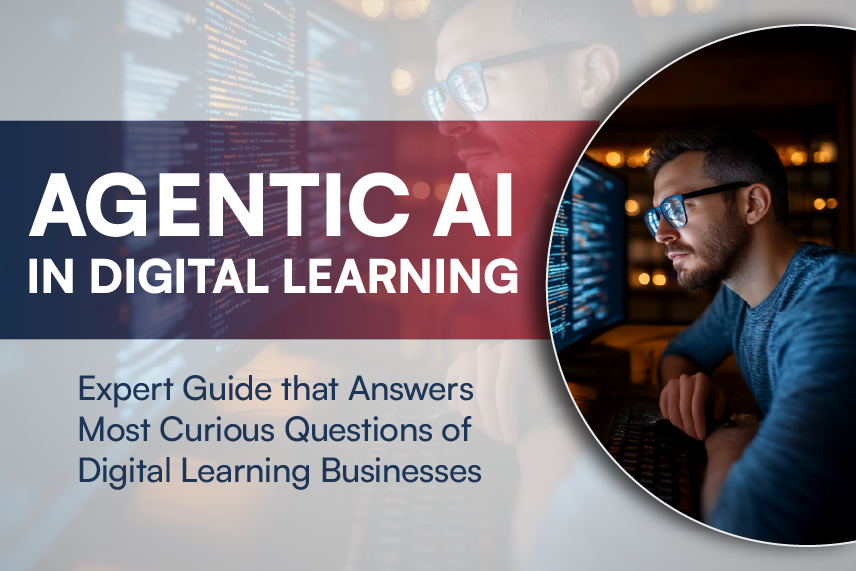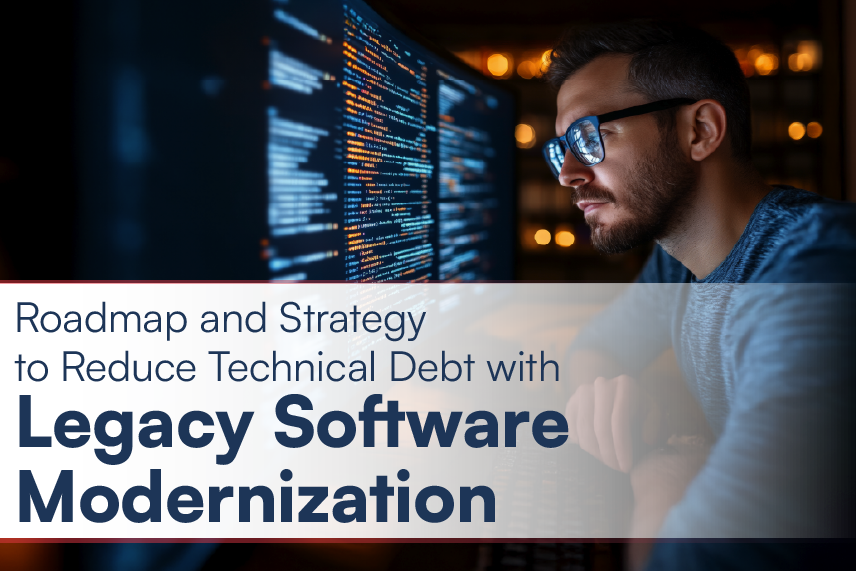
Table of Contents
-
- What is Technical Debt?
- 4 Benefits of Legacy Apps Modernization
- 5 Ways to Tackle Technical Debt with Legacy Apps Modernization
- Road to Legacy Apps Modernization: 6 Steps to Reduce Technical Debt
- Addressing Product Modernization Using Comprehensive Strategy
- Legacy Apps Modernization Success Story of Harbinger Customer
Technical debt is akin to the mounting repair bills of an aging car—slowly eroding its worth over time. Legacy applications are as costly liabilities for business today. Discover how modernizing legacy applications can reduce technical debt, unveiling a new era of agility and innovation for organizations.
What is Technical Debt?
Technical debt refers to the long-term costs and complications that arise from choosing easy, short-term solutions over better, more strategic approaches. It accumulates over time from quick fixes and outdated systems, burdening a company’s resources and efficiency.
Technical debt can severely slow down innovation. When a significant portion of your IT budget and resources is tied up in maintaining and fixing legacy systems, it leaves little room for new initiatives. Eventually, it restricts your business from quickly adopting new technologies or responding to market changes. This ultimately takes a toll on your competitive edge.
Moreover, new tech initiatives often require existing system integration for their success. However, high levels of technical debt can easily lead to complex, time-consuming, and expensive integrations. This not only delays the implementation of new projects but also results in compromised solutions that are less effective and more difficult to maintain.
30% of CIOs believe that more than 20% of their technical budget intended for new products is diverted to resolving technical debt issues. Additionally, technical debt comprises 20-40% of the entire technology estate value, highlighting its pervasive and escalating nature across organizations.
4 Benefits of Legacy Apps Modernization
So, why modernize legacy applications? Let’s break it down:
Cost Efficiency: Modern systems are more efficient and cheaper to run in the long term. Yes, there’s an upfront cost, but maintenance and operation savings can be substantial.
Improved Performance and Scalability: Modern applications are designed to handle more users, data, and transactions with ease. They’re built to grow with your business.
Enhanced Security: Legacy systems are often more vulnerable to cyberattacks because they aren’t updated with the latest security measures.
Better Integration: Modern applications are built to effectively communicate with other systems. They have APIs that make it easy to integrate with new tools and technologies.
By addressing technical debt through modernization, organizations not only improve their current operational capabilities but also position themselves in a better way for future growth and innovation.
5 Ways to Tackle Technical Debt with Legacy Apps Modernization
Now, let’s see how the modernization of legacy software helps take technical debt head-on.
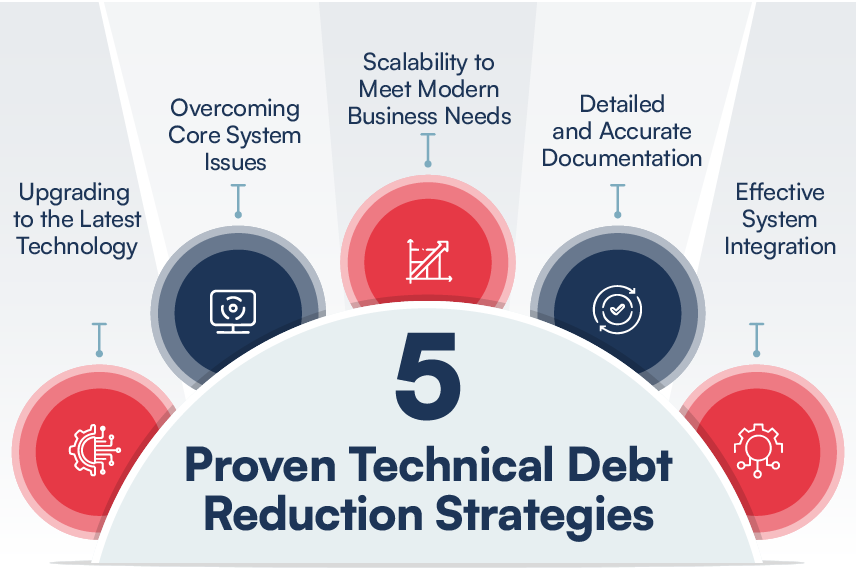
1. Upgrading to the Latest Technology
Outdated systems are the crux of technical debt in many legacy applications. These systems often run on old software and hardware that are no longer supported by vendors. Software modernization can help you upgrade to future-ready technologies that are faster, more efficient, and more secure. With Generative AI, you can accelerate this process by analyzing system dependencies and identifying optimal technology stacks or migration paths.
This effective approach will enable you to not only reduce the risk of system failures but also decrease maintenance costs. For instance, you can do away with constant hardware upgrades and enable automated software updates by moving from an on-premises server to a cloud-based solution.
2. Overcoming Core System Issues
By implementing temporary solutions, you will be able to address the symptoms but not the root cause of system issues. Over time, these issues accumulate, only to lead to a fragile system that’s prone to breaking.
Generative AI tools can automate the identification of root causes and generate solutions, reducing the reliance on temporary patches. This reduces the odds of unexpected failures and the need for urgent, disruptive fixes.
3. Scalability to Meet Modern Business Needs
Legacy systems are often not designed to handle the scale of modern business operations. They may struggle with increased load, leading to slow performance and downtime. Modernizing legacy applications involves designing for scalability from the outset.
This is done by using cloud services, microservices architecture, and other modern practices that allow your system to grow and adapt with your business needs. You can also leverage Generative AI to simulate future scenarios and get recommended scalable architectures tailored to anticipated growth. The end result will be an application having the ability to bear peak loads without compromising performance.
4. Detailed and Accurate Documentation
Over time, the documentation for legacy systems can become outdated or lost, especially if the original developers move on. This makes it challenging for current teams to understand, maintain, or upgrade the systems.
Legacy application modernization projects commonly involve creating comprehensive, up-to-date documentation as part of the process. With Generative AI, outdated documentation can be quickly updated or generated from codebases and system logs. This improves knowledge transfer, reduces onboarding time for new team members, and ensures everyone has a clear understanding of the architecture and functionality of the systems.
5. Effective System Integration
Legacy systems can be isolated and difficult to integrate with new technologies. This creates silos within an organization, where data and processes are fragmented across different systems.
Modern applications are designed with integration in mind, using standard protocols and APIs to ensure smooth communication between systems. Generative AI-powered tools streamline the development of APIs and integration layers, ensuring seamless interoperability across systems. This enables more efficient workflows, better data sharing, and a more cohesive IT environment.
Unlock seamless eLearning platform interoperability and streamline learning ecosystem with LTI integration.
Road to Legacy Apps Modernization: 6 Steps to Reduce Technical Debt
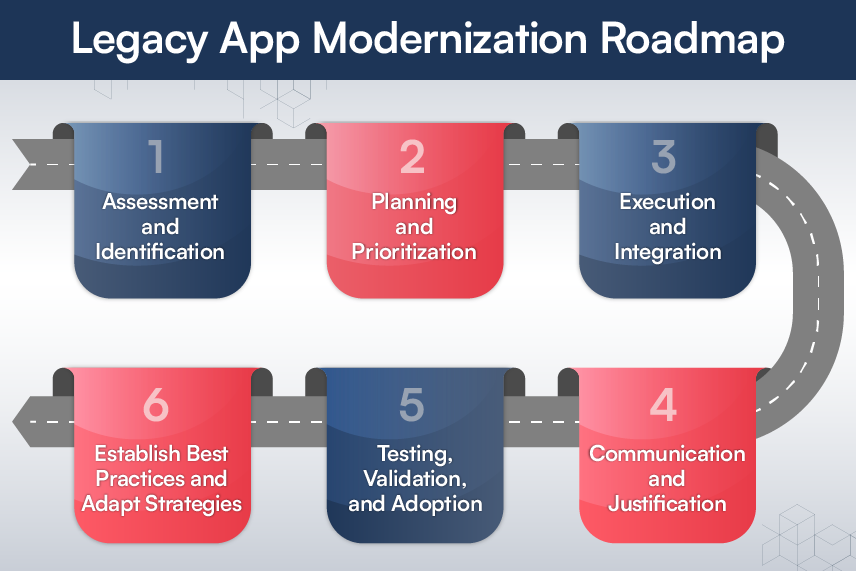
Modernizing a legacy app isn’t a one-size-fits-all process. Here’s a powerful roadmap to guide you:
Step 1: Assessment and Identification
Begin with a rigorous assessment of your current systems. Conduct regular code reviews to identify areas of technical debt. Maintain a debt log to document and prioritize based on impact and urgency.
Step 2: Planning and Prioritization
Develop a legacy application modernization plan that includes goals, timelines, budgets, and necessary resources. Allocate dedicated time in sprint planning for addressing technical debt. Promote continuous refactoring to prevent debt accumulation. Decide which systems or parts of systems to tackle first. Focus on high-impact areas that will deliver the most significant benefits early on.
Step 3: Execution and Integration
Begin the legacy application modernization process, whether it’s refactoring code, migrating to the cloud, or implementing new technologies. Implement automated testing to identify and prevent new issues. Implement continuous integration to maintain code quality and prevent regressions.
Step 4: Communication and Justification
Keep stakeholders informed about technical debt implications and risks. Present clear cost-benefit analyses to support technical debt reduction efforts. Ensure transparency about the existence and impact of technical debt.
Step 5: Testing, Validation, and Adoption
As you modernize, continuously test, and validate your changes to ensure everything works as expected. Ensure your team is on board and knows how to use the new systems. Provide training and support to facilitate a seamless transition.
Step 6: Establish and Adopt Best Practices
Enforce coding standards to minimize debt accumulation. Cultivate a culture of learning and sharing knowledge to promote best practices and adapt strategies as needed.
By integrating these steps into your legacy application modernization process, you can effectively manage technical debt. This will help ensure your IT systems remain healthy and agile while positioning your business for future growth.
Addressing Product Modernization Using Comprehensive Strategy
Based on Harbinger’s experience of helping organizations with the planning and execution of their product modernization strategies, there are four key technological aspects relevant to the overall system modernization—Infrastructure, Experience, Data Strategy, and Compliance. Modernization is not a single, point-in-time event but a journey of carefully planned incremental steps.
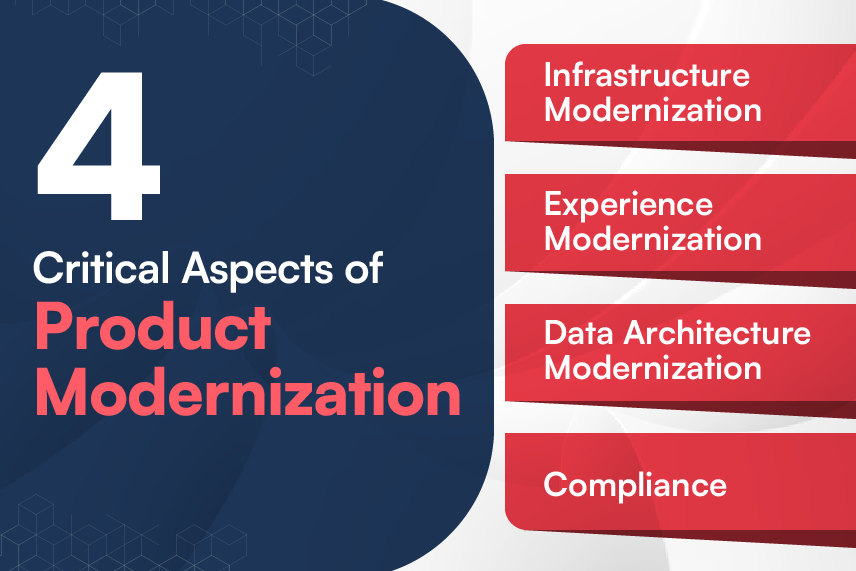
1. Infrastructure Modernization: Moving to the Cloud and Beyond
Infrastructure modernization is about enhancing your IT backbone to make it more resilient, flexible, and cost-effective. A primary aspect of this is cloud migration, which allows businesses to shift from outdated, on-premises servers to scalable cloud environments. Moving to the cloud reduces maintenance costs, improves security, and allows automated updates, which significantly lower technical debt.
Additionally, enabling mobile availability through responsive web applications and mobile apps is crucial. It ensures your systems are accessible anywhere, anytime, enhancing user experience and operational efficiency. This step is particularly important as remote work and mobile access become standard in modern business operations.
2. Experience Modernization: Enhancing User Interaction and Engagement
Modernizing User Experience Goes Beyond Aesthetics: It’s about creating intuitive, engaging, and efficient interfaces that align with modern user expectations. Incorporating UI/UX design best practices, implementing chatbots or conversational AI agents, and integrating IoT devices are crucial elements.
Chatbots and Conversational AI: These enhance customer service, automate responses, and provide instant support, reducing the load on human agents while increasing efficiency.
UI/UX Improvements: Streamlining navigation and design makes the application easier to use, which can directly impact customer satisfaction and reduce training times for employees.
IoT Integration: For industries like manufacturing, logistics, and healthcare, IoT devices can provide real-time data, optimize operations, and offer predictive maintenance, further reducing technical debt.
Harbinger modernized the UI/UX of a leading Ed Tech and business solution provider’s payment platform for faster online enrollment and streamlined admissions management.
3. Data Architecture Modernization: Storing, Analyzing, and Leveraging Data
Data is the lifeblood of modern business, and its architecture must evolve to support robust, scalable, and efficient systems. Modernizing data storage solutions, such as migrating to cloud-based data lakes and warehouses, ensures data is securely stored and easily accessible.
Data Storage: Modern data storage solutions provide improved scalability, security, and access speed. They also support big data applications, enabling advanced analytics and AI-driven insights.
Data Analysis: Leveraging modern data analysis tools can turn raw data into actionable insights, enhancing decision-making. For example, predictive analytics can help foresee customer behavior, market trends, and even potential system failures, enabling preemptive action.
4. Compliance: Meeting Industry Standards and Avoiding Penalties
Ensuring compliance addresses the specific regulatory needs of various industries. For example, the healthcare industry must adhere to strict compliance standards, such as HIPAA, which protect patient data and require secure, auditable systems.
Cost of Compliance: Non-compliance penalties can be extremely high, making modernization not just a choice but a necessity. By upgrading to compliant systems, companies can avoid fines, enhance security, and build trust with clients.
Certifications and Standards: Modernization helps organizations align with industry standards and certifications, which are often necessary to operate or gain a competitive edge.
Legacy Apps Modernization Success Story of Harbinger Customer
Legacy applications often accumulate technical debt over time, limiting a company’s ability to innovate, scale, and meet the demands of modern businesses. In a recent success story, Harbinger partnered with a US-based employee engagement product company to address the limitations of their legacy systems. The client faced challenges that hindered growth and agility:
- Inability to scale product infrastructure
- Inconsistent user experiences
- Frequent system downtime
- Poor integration capabilities
- High maintenance costs
Harbinger’s solution was to rearchitect their legacy employee engagement platform by migrating it to the Azure cloud. By modernizing the system architecture, we enabled the client to reduce operational inefficiencies, optimize performance, and futureproof their platform for long-term success. The result was a cloud-based, scalable platform with faster response times, enhanced product agility, and improved integration capabilities, all while significantly lowering maintenance costs and technical debt.
Want to learn more? Download the case study.
Parting Thought
Modernizing legacy applications is not just about staying on top of the latest trends; it’s a strategic move to reduce technical debt and position your business for future growth. If you’ve been hesitant about modernizing your legacy applications, think of it as an investment in the future of your business. It might seem daunting at first, but the long-term benefits outweigh the initial effort and cost.
At Harbinger, our expertise and tailored solutions make legacy application modernization seamless and effective. We provide a comprehensive approach, addressing both technical and strategic needs. Our team of experienced professionals delivers customized solutions, proactive support, and a commitment to excellence. We ensure your transition to modern systems is streamlined and successful.
Invest in legacy app modernization and technical debt reduction with Harbinger to enter a new era of agility, innovation, and growth for your organization. Ready to take that leap? Reach out to us.



